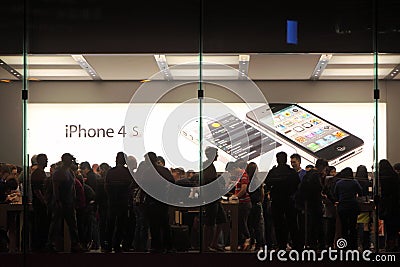On the heels of Walter Isaacson’s officially approved bio of Steve Jobs comes Adam Lashinsky’s unauthorized take on Apple — including the unsettling extremes to which the company goes to keep a lid product announcements.
While Apple has always been a great role model for product marketers, the lessons proffered here should have come with a disclaimer. Something to the effect that “Your results may vary because Steve doesn’t run your outfit”.
Still, the way we see it, the spirit of these lessons is practical to creation of marketing content. No disclaimers necessary. You can apply them immediately.
Apple is, and always has been, all about the way it dramatizes and communicates its brand. Specifically, the engaging craftsmanship of the content it presents to the marketplace in everything from its TV commercials to its product packaging. We can all take lessons:
1. Great content comes first. Long before the lines form outside its stores and well after, Apple floods the zone with its message. And study after study shows conclusive evidence that in today’s Web 2.0 world, where the buying process begins with search, those brands with superior content published most frequently are the first found and the most followed. Content drives interest, conversions, leads and financial success.
2. Publish and promote. The fact that you don’t have the budget for TV on Oscar night or the NCAA Tournament should not prevent you from creating content tailored to the interests and aspirations of your buyer. Content that you make easily accessible and widely visible. Toward this end, make it standard procedure to re-purpose everything you generate: turn customer stories into press releases, competitive analyses into guest-articles (or blog posts) that describe industry trends, application notes into case studies. Make all of it social on the sites where they share professional tips with peers and learn about best practices. Understand how you can make your solutions more relevant to what’s trending in your buyer’s communities.
3. Telling trumps selling. Too much marketing content screams “You gotta get this!” when it should inspire “This, I must have.” Just as the most successful B2B salespeople are seen as problem-solvers, make your content resonate with the kinds of issues and questions that beset your customers — real users. People want to be informed, educated and engaged, not sold to. There is a fine line here but it’s distinct. Assuming a third-party POV and advocating on your buyer’s behalf puts you in the right frame of mind. Avoid implying that you have all the answers, just the eagerness to look for them.
4. One company, one voice. Everything you create should look and sound like it came from no other brand but yours. In a me-too, look-alike online world of generic templates and “replicants”, strive to stand out by being out-standing. You might fall short of “insanely great” but you can and should establish a tone that’s yours, based on the problem you solve and the way only you can solve it. Apple mastered this technique early on and elevated it to a high art form in recent years. The “whole” of great marketing content always exceeds the sum of its parts.
5. People don’t read white papers and case studies. They read what interests them. Strive to create the kind of content you want to see from your own vendors. You’re writing to someone, not at them. Just as a personal letter (remember those?) will always be opened first, so too is content that’s made more personal through examples of real-world applications.
6. Sometimes, less is more. Apple’s reputation for rejecting proposals for new products is a good model for all marketing initiatives, including new product material, literature and collateral. The first question to ask is if this new idea can be integrated into an existing document or web page to make them more compelling and valuable.
7. Value expertise. Apple hires the best in their fields then laser-focuses them on their assigned tasks. Third-party writing services create content for a living. They have to do a better job.
8. Own your message. Crafting, controlling and repeating the message is “classic Apple”, Lashinsky says. There’s a B2B PR lesson here.
9. Calculate the worth of the first impression you want to make. While we won’t pretend that Apple’s “spending whatever it takes” is consistent with your marketing budget realities, don’t lose sight of another reality: that your content is the first impression you make on prospective customers. Apple hasn’t always had its Fort Knox-like resources. Each of its very first computers contained, at great cost to the company, added weight to make them seem more substantial. Whatever it is, if it bears your logo it becomes who you are. How important is it to your shareholders for their company to make a good impression on an important prospect?
10. Be known for “remarkable” content. Jobs’ boast of “insanely great” was, of course, aspirational but so is a lot of Web 2.0 parlance. The lesson here: if you want more leads of higher quality you must attract more visitors who fit a target profile that will remain dynamic. In other words: a moving target. This target is attracted by content created to be compelling, engaging and always relevant.











